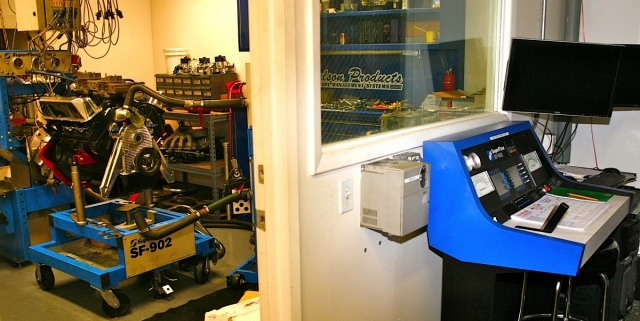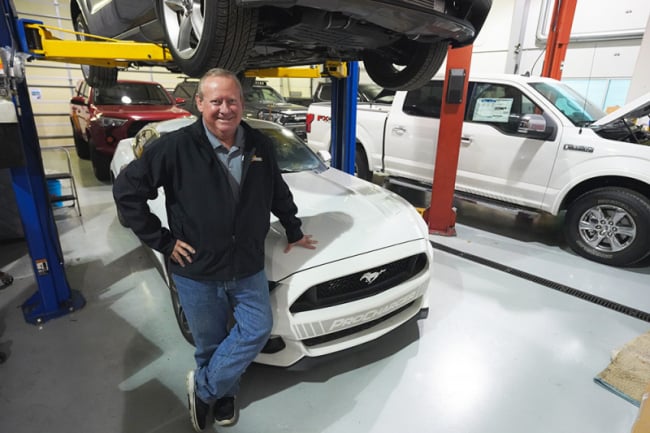 Born and raised in Southern California’s San Fernando Valley makes it easy to become obsessed with the car culture of hot rodding. There’s cruising Van Nuys Blvd. and street racing at any number of late-night hot spots in the area. That pretty much tells the story of Brad Lagman’s early days. Like many red-blooded American boys in the ‘70s and ‘80s, Brad built his El Camino (which he still has) as a hot street car in high school and ended up working at the Super Shops on Van Nuys to fund his passion.
Born and raised in Southern California’s San Fernando Valley makes it easy to become obsessed with the car culture of hot rodding. There’s cruising Van Nuys Blvd. and street racing at any number of late-night hot spots in the area. That pretty much tells the story of Brad Lagman’s early days. Like many red-blooded American boys in the ‘70s and ‘80s, Brad built his El Camino (which he still has) as a hot street car in high school and ended up working at the Super Shops on Van Nuys to fund his passion.
Following a stint with well-known racer Bob Lambeck, Lagman struck out on his own by opening Quarter Mile Performance (QMP) in Chatsworth, CA just after the turn of the century. From behind the nondescript front door, over the next decade the facility progressed beyond a standard engine-build shop to supporting well over a million dollars in machinery and four additional full-time employees.
It’s that specialized automotive equipment that Lagman feels separates QMP from its competitors, as well his work ethic and willingness to work with customers with problems.
“We try to be on the leading edge of machining. That’s the wave of the future and it brings customers in,” he says, pointing to his diamond hone as one of the game changers in high-quality machining.
“I was doing a 500ci Pro Stock motor for a guy, and I hired a really big name engine builder to come in and help since I’d never done one before,” adds Lagman. “He told me he would work in the shop but the only thing missing is the hone. I asked him what he was talking about and he said he didn’t care how good I am on the CK 10, without the diamond hone nothing was going to happen.”
This is the diamond hone setup that bores cylinders to exact tolerances for optimum ring seal. The Sunnen machine allows the machinist to control the speed and depth of the plunge, and controls the heavy hone head, shoes and diamond stones stored in the chest next to it. There are stones for every .0002-inch of bore.
Diamond-sharp honing
He was referring to the block-honing operation. The factory Sunnen hone head uses two shoes and stones that is adequate for most engines. However, a high-end race engine demands much more accurate, finite cylinder roundness. Lagman’s hone head comes from Germany and weighs about 40 pounds…just the head.
QMP’s 3,500hp Bullet
Scott Oksas runs a Pro Mod Mustang, and relies on QMP for his power. The combination is based on a 480ci Brad Anderson block and heads with twin turbos (see engine in title lead photo). QMP built and ran the engine on the dyno, but Lagman cautions that engines like that can not be tuned on the dyno — they have to be in the car to compensate for all of the variables. You can see Oksas’s engine making a 2,050-horsepower pull on a YouTube elsewhere in this story. The car has made runs in the 5-second zone at NMCA West races, most notably a 5.94 at a screaming 260 mph.
“It demands geometry as soon as you put it in the cylinder,” Lagman says, noting that QMP’s head uses eight shoes and has holders and diamonds for every .0002-inch. After honing, that cylinder is perfectly round for vastly better ring seal. “If you can’t get it round you’ll never have ring seal, and when you’re talking rings that are only .024-inch thick, you’ll never get good seal and end up with blow-by.”
Lagman says that A-B testing on a 700-horsepower Super Stock engine, with no changes other than the honing operation, saw an increase of 10 horsepower and three inches of vacuum. Ten horsepower on an NHRA Stock engine is huge. On a GM LS spec engine used in a circle-track racing, it made 12 more horsepower after the hone, and the crankcase vacuum went from 0 to 12 inches. That’s power. Of course, the hone head, diamonds, and all is roughly a $140,000 investment.
“You gotta do a lot of blocks to get that back!” sighs Lagman, adding that QMP is one of about two privateers (non-NASCAR Cup-level) in the U.S. to have the diamond hone. “It’s not like you can send your block to Hendrick and have it honed. It ain’t gonna happen.”
QMP charges double to run a block through the diamond hone because it takes more time, but it comes with a printout and photo of each cylinder to show the specs.
It’s all custom to every motor. — Brad Lagman, QMP
“You can do a good job with a CK 10, but not a great job. I’ve seen more work come from that [diamond] hone than all the other equipment in my shop,” says Lagman.
The hardware at QMP allows the shop to handle 100 percent of the machining, porting and building of anything from a 500-horsepower street engine all the way up to a 3,000-plus Pro Mod bullet. In addition to the Sunnen CK 10-based diamond hone and twin CNC mills are a Sunnen VGS 20 for valve jobs, a Sunnen DCB 2000 balancer, VR 8000 valve grinder, a cam tunnel machine (custom made by Lagman with a BHJ box), a crank grinder, electronic valve spring tester, Audie Cam Pro Plus and Dynomation software and a Superflow SF-600 flow bench to test head and manifold flow. The last step and the one that every QMP-built engine sees is a trip to the Superflow 902 engine dyno.
Thanks to all of this equipment, and a big part of the reason he has it all, is that Lagman doesn’t have to wait on any outside machine work slowing him down.
These are QMP’s CNC machines (top left). The closest one is a Sunnen RMC V30, and the other is a Centroid A532 5-axis. Top right photo shows torque plates QMP custom made for a 500ci Pro Stock engine, but competing with the well-financed teams is tough, Plus, Lagman says he can build 10 street engines in the time it takes to build one Pro Stock engine, and make a lot more money with the street engines. Bottom left shows the Sunnen RMC V30 CNC machine that allows absolute control over block machining. QMP can change bore centers, bolt holes—anything they want. And in the bottom right photo, Lagman took a BHJ cam boring box, spun it around and made his own fixture so that he can put bigger cam bores in a block, up to a 78mm bore.
Waiting on parts
“Our biggest problem was waiting on parts, waiting for other shops to get them done. When you get heads from one guy, a block from another, you always end up waiting longer than expected. But now we get a bare block and we can move the bore centers, put our own head bolt-holes in it, that kind of stuff. There are only a handful of guys that can do it. One of those guys actually forced me to buy my CNC machine because I couldn’t wait for him,” says Lagman, noting that the wealth of equipment at QMP now has it doing machine work for other shops. “Now they’re waiting on me.”
But QMP still has to deal with waiting, only now it is now centered on getting parts.

A Superflow dyno is used on every engine build to ensure performance and catch any potential problems before the customer picks up the engine. On the stand in the photo is a Ford FE that will go in a vintage boat.
“I can’t stock anything because everything’s different. It’s all custom to every motor. Getting the parts actually delivered here is tough. Comp [Cams] is really good, probably a 98% fill rate, but all of my mornings are spent on the phone ordering and tracking parts,” says Lagman, noting those delays increase the wait for high-end race engines up to a year.

Lagman says that when assembling an engine, you have to pay attention. He doesn’t allow any distractions, including cell phones, in the engine room. Every engine gets a spread sheet filled out during assembly with every torque figure, what lube was used, clearances, etc.
“There’s about a million and a half dollars worth of equipment in here,” says Lagman. “That takes a lot of motors to pay for and is why we work 80 hours a week here. It’ll take a while to pay everything back, but we like it. If we worked 40 hours a week we’d have to close the doors.”
Those hours are not for the faint of heart and Lagman admits that you have to take a break every now and then or you’ll pop. To that end, there are eight TVs in the shop, so even when working weekends the crew takes those breaks at times to download their brains a little bit.
“When I’m here on Sunday, I can watch four different NFL games at once on any of the TVs so I don’t feel like I’m here by myself,” chuckles Lagman.
Although the company struggled at times, Lagman is proud that QMP grew on its own and has survived with a simple mantra of building quality product and willing to work with the customer.
“You have to do 10 good things to get one guy to talk about it,” sums up Lagman, “you do one bad thing and 100 people know about it.”


























